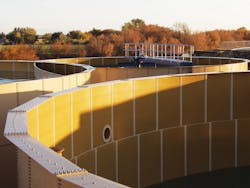A Slice of Wastewater Treatment Success
undefined
Glanbia Foods Inc. operates a large cheese-making operation near Twin Falls, Idaho. The plant takes in about 10 million lb per day of milk, produces about 1 million lb per day of cheese and generates on average 1.25 million gal per day of high-strength wastewater.
Since 2005, wastewater has been treated using:
• A covered, low-rate anaerobic lagoon (LRAL) with biogas recovery and beneficial use;
• A nitrification activated sludge basin (ASB); and
• An integral clarifier (IC) at one end of the ASB.
The plant was designed to removed organics and solids, with final effluent stored in a five-day pond and reused in the irrigation of company-owned agricultural land. The IC did not consistently or effectively remove total suspended solids (TSS). The land application of effluent caused a significant problem, however, because the treatment plant did not remove nitrogen, which can exceed 120 mg/L in Glanbia wastewater, causing concern with future nitrate contamination of the groundwater.
While sludge is not wasted from the system routinely, it is returned to the LRAL for anaerobic treatment and periodically is removed from the LRAL to be dewatered and either transported to a commercial composting operation or landfilled.
The challenges of improving TSS and nitrogen removal included the need to retrofit improvements that perform well with the 2005 plant and minimize interruptions in treatment during installation. Also, additional treatment units had to fit in limited available land and be installed in an area with shallow bedrock.
Plant Performance Objectives
Glanbia set design criteria for improvement of treatment tied to state of Idaho irrigation permit requirements, with the addition of a criterion for total nitrogen to eliminate the threat of nitrate contamination. Table 1 shows these criteria along with influent concentrations and percentage of time the effluent criteria were achieved. In addition to meeting these criteria, the upgrading objectives included tripling the waste activated sludge pumping rate to better balance suspended solids loading rates in biological treatment and final clarification.
Treatment Plant Upgrades
In 2009, facilities were added to the treatment plant for anoxic treatment of nitrogen, a new circular clarifier and sludge return and wasting increases. The anoxic treatment selected was series, completely mixed, suspended growth tanks with a re-aeration zone before the outlet of the second tank. Based on previous bench-scale denitrification testing, a cheese plant whey processing byproduct known as permeate was selected as the carbon source for the anoxic process. Figure 1 (see page 26) shows the upgraded plant.
The upgrades were constructed from July to December 2009. The anoxic tanks and clarifer were designed for gravity flow to avoid forward-flow pumping. The configuration and siting of these units were coordinated carefully using the results of a geophysical survey of the shallow volcanic bedrock (1 to 10 ft below ground surface). The survey showed a dip in the bedrock where the clarifier could be placed to achieve gravity flow from the ASB through the new units to the irrigation pond. Anoxic tank crossover piping and outlet features had to be modified to achieve gravity flow through the range of design flows.
The last stage of construction, removal of the IC and installation of two new lines of aeration piping and diffusers in the ASB, occurred in frigid weather in early December 2009 and required the potentially hazardous entry of work crews into the 16-ft-deep, flexible membrane-lined basin. The entire 3.15 million gal of ASB/IC contents had to be removed with temporary pumping, while LRAL effluent was bypassed to the new clarifier. The removal of the contents and IC curtain wall and hardware and the installation of aeration equipment were accomplished within a week without mishap or liner damage.
Upgraded Plant Startup & Performance
The new facilities started up in the first quarter of 2010, and performance was demonstrated from March to May 2010. The startup period and early part of the performance demonstration were characterized by intermittent high flows and organic loadings. These conditions caused excessive releases of solids from the LRAL that traveled through the entire plant and overloaded the clarifier. An additional two-week period of excessive loading occurred in the middle of the performance period, from April 30 to May 11.
The conditions in the anoxic process that produced excellent denitrification were as follows:
• Influent total nitrogen: 70 to 125 mg/L
• Permeate feed:
- Carbon content: 283,000 mg/L chemical oxygen demand (COD)
- BOD < ½ COD
- COD:N (Influent) Ratio > 6:1
• Mixed liquor suspended solids: 3,200 to 4,400 mg/L
• Anoxic contents recycle: 50%
• Reducing conditions:
- Dissolved oxygen < 0.2 mg/L
- Tank No. 1 oxidation reduction potential (ORP): -30 to -50 mV
- Tank No. 2 ORP, -10 to -25 mV
Maintaining these conditions and following clarification, total nitrogen measured less than 10 mg/L for a combined eight weeks (for the two performance periods), and removal efficiency averaged more than 90%. During these periods, effluent TSS and BOD were as follows: first period BOD (34 mg/L), first period TSS (13 mg/L), second period BOD (12 mg/L) and second period TSS (13 mg/L).
Summary & Conclusions
Upgrades were designed, constructed and started up, and performance was demonstrated capable of achieving objectives for nitrogen removal and improved TSS removal. The plant’s upgrades can allow Glanbia to continue year-round effluent land application at its cheese plant without concern over groundwater contamination.
The permeate produced at the cheese plant serves as a good carbon source for anoxic treatment, producing nitrogen removal of 90% to 96% without causing elevated BOD or TSS in the clarified effluent. Excessive influent flow and organic loadings, however, can cause upsets all the way through the upgraded plant, impairing achievement of nitrogen, BOD and TSS performance. These influent loadings will need to be equalized before continuous achievement of target levels is possible.
Download: Here
